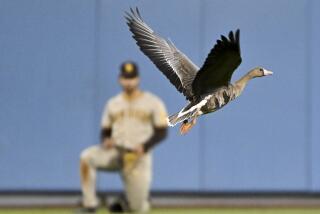Now You All Come Back, Hear?
- Share via
One thing Billy Thornborough learned early on about homing pigeons was that the plump and extremely sociable birds don’t always come home.
“Sometimes they fall in love on the way home. Sometimes they [land] on the highway and get smacked by a semi. Sometimes you’ll get a call from someone and they’ll say, ‘I found your pigeon in my swimming pool -- he was thirsty,’ ” he said.
Thornborough, 57, of Newbury Park has lost 20 young birds since he began training for this fall’s pigeon racing season, which runs September to November. But he remains undeterred.
Like most involved in the growing sport, Thornborough is a rare breed of bird lover who is willing to travel hundreds of miles to release a flock of birds only to time their return home.
“I’d love nothing more than just to fly birds all day long,” said Thornborough, who manages a San Fernando Valley auto dealership when he’s not tending to the 70 birds he keeps in a coop he built in his backyard. “I just enjoy watching them.”
With less than two weeks left before the first race of the season, Thornborough and his birds are in training. Several times a week, he wakes at 4:30 a.m., packs a few pigeons into wire-mesh crates and drives them in his pickup truck to a nearby park for an exercise run.
This is his favorite part of the day.
“There’s just something about opening their cages when the sunlight is coming through, with the noise of their wings beating,” he said.
His homing pigeons are part of the Tri City Combine, a racing club that includes members from Santa Barbara, Thousand Oaks and Ventura. On Sept. 4, they’ll compete in a race that starts in Kettleman City, in the Central Valley, and ends at their respective home bases, each more than 100 miles away. It’ll take the birds roughly three hours to fly home.
Over the course of the fall season, each racing group will be awarded points that will be tallied before a winner is declared at the end of the year. Winners will be awarded medals, trophies and cash prizes.
To help pigeon racers, known as “flyers,” keep track of their birds, each pigeon is fitted with a registration band around one ankle that identifies the animal and its trainer. An electronic chip placed on the bird’s other ankle clocks its time into a master computer. The average airspeed of a racing pigeon is 50 mph, but some have been known to reach speeds of 80 mph.
The cause of the pigeons’ so-called homing instinct -- an internal compass that guides a bird to the home it establishes soon after birth -- is uncertain. But theories include the birds’ keen sense of sight and hearing and use of the sun and other celestial bodies to determine position.
The sport of pigeon racing, which started in Holland, was brought to the United States by 19th century European immigrants. It caught on quickly in New York and other urban neighborhoods, where kids would chase pigeons on rooftops.
“It’s been referred to as the poor man’s horse racing,” said Deone Roberts, sport development manager for the Oklahoma City-based American Racing Pigeon Union, which has about 10,000 members. “You’re not watching them run around the track, but you’re excited. These guys can’t even sit down when they’re watching one come in from a race. They’re hopping up and down.”
The pigeon union has been around since 1910, but its membership has increased recently, especially among families, because everyone can participate in the sport of pigeon racing, Roberts said. “Having children become involved and take responsibility helps them with their self-esteem and leadership skills,” she said.
Homing pigeons have a long history. In 12th century Baghdad, the supreme ruler had a pigeon post office to deliver messages throughout the kingdom. During both World Wars, the Army used pigeons to communicate on the battlefield. Newspapers used them to carry breaking news.
Thornborough, who became involved in pigeon racing two years ago, said it has been an all-consuming passion, as he starts and ends each day tending to his birds. With no children of his own, he often speaks of his pigeons with fatherly affection.
“They all have their unique personalities,” he said.
And like many parents, he gets antsy when they’re late.
“If a bird doesn’t come home, you stay up all night ... like a mother hen,” he said.
With molting season in full swing, a quarter of Thornborough’s yard is covered in feathers. Sometimes, he imitates the birds’ low grunt while tending to them in the loft.
“My wife says she feels like a widow,” he said. “And I say, ‘Yes, you’re a pigeon widow, but at least you know where I am. I’m in the backyard.’ ”






